

Fallschirmjäger (World War II) The Fallschirmjäger were the paratrooper (German: Fallschirmjäger) branch of the German Luftwaffe before and during World War II.

They were the first German paratroopers to be committed in large-scale airborne operations and came to be known as the "green devils" by the Allied forces they fought against.[1] Throughout World War II the Fallschirmjäger commander was Kurt Student. The Soviets were the first to demonstrate the military possibilities of airborne infantry in the 1930s with a series of maneuvers held in 1935 and 1936.[3] Though somewhat crude (the Soviet paratroopers had to exit their slow-moving Tupolev TB-3 transporters through a hatch in the roof and then position themselves along the wings and jump together), the exercise managed to land 1,000 troops through air-drops followed by another 2,500 soldiers with heavy equipment delivered via airlandings.
Over 54,449 paratroops were killed in action and over 8,000 are still listed as missing in action. 3.7 cm Pak 36. The Pak 36 (Panzerabwehrkanone 36) was a German anti-tank gun that fired a 3.7 cm calibre shell.
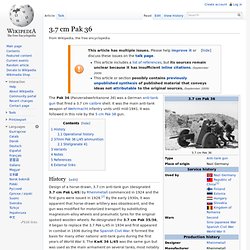
It was the main anti-tank weapon of Wehrmacht infantry units until mid-1941. It was followed in this role by the 5 cm Pak 38 gun. History[edit] Design of a horse-drawn, 3.7 cm anti-tank gun (designated 3.7 cm Pak L/45) by Rheinmetall commenced in 1924 and the first guns were issued in 1928.[2] By the early 1930s, it was apparent that horse-drawn artillery was obsolescent, and the gun was modified for motorized transport by substituting magnesium-alloy wheels and pneumatic tyres for the original spoked wooden wheels.
Re-designated the 3.7 cm Pak 35/36, it began to replace the 3.7 Pak L/45 in 1934 and first appeared in combat in 1936 during the Spanish Civil War. Operational history[edit] During May 1940 Western Campaign, the Pak 36 being a small-calibre weapon, it was found to be inadequate against allied tanks like the British Mk.II Matilda, and the French Char B1 and Somua S35. Pzgr Pzgr 40. 8 cm Flak 18/36/37/41. German submarine U-234. German submarine U-234 was a Type XB U-boat of Nazi Germany's Kriegsmarine during World War II.

Her first and only mission into enemy territory consisted of the attempted delivery of uranium oxide and German advanced weapons technology to the Empire of Japan. After learning of Germany's unconditional surrender, the submarine's crew surrendered to the United States on 14 May 1945. Construction[edit] Originally built as a minelaying submarine, she was laid down at the Germaniawerft yard in Kiel on 1 April 1942; U-234 was damaged during construction, but launched on 22 December 1943. German Commerce Raiders. Attacks on United Nations personnel during the 2006 Lebanon War. Aftermath of IDF airstrike on UN patrol base Khiam, Lebanon, 2006 The entrance to the UN base where four UN peacekeepers were killed during the 2006 Lebanon conflict During the 2006 Lebanon War, a number of international incidents occurred in Lebanon, largely involving United Nations personnel in Lebanon, who have come under a number of attacks.
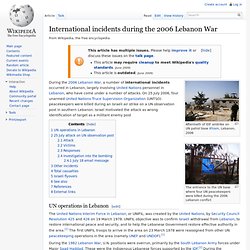
On 25 July 2006, four unarmed United Nations Truce Supervision Organization (UNTSO) peacekeepers were killed during an Israeli air strike on a UN observation post in southern Lebanon. Battle of Bint Jbeil. The Battle of Bint Jbeil was one of the main battles of the 2006 Lebanon War.
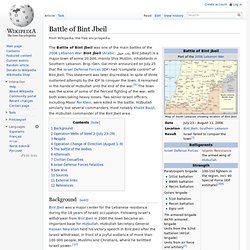
Bint Jbeil (Arabic: بنت جبيل, Bint Jubayl) is a major town of some 20,000, mainly Shia Muslim, inhabitants in Southern Lebanon. Brig. -Gen. Gal Hirsh announced on July 25 that the Israel Defense Forces (IDF) had "complete control" of Bint Jbeil. This statement was later discredited. Battle of Maroun al-Ras.
The Battle of Maroun al-Ras was a battle of the 2006 Lebanon War that took place in Maroun ar-Ras, a small village in southern Lebanon on the border with Israel, and Jall ad-Dayr, a nearby Hizbullah stronghold.
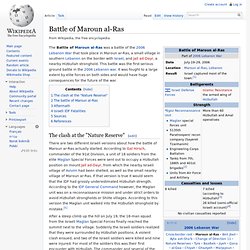
This battle was the first serious ground battle in the 2006 Lebanon war. It was fought to a large extent by elite forces on both sides and would have huge consequences for the future of the war. The clash at the "Nature Reserve"[edit] After a steep climb up the hill on July 19, the 18-man squad from the Israeli Maglan Special Forces finally reached the summit next to the village. Suddenly the Israeli soldiers realized that they were surrounded by Hizbullah positions. Hino Komuro M1908 Pistol. The Hino Komuro M1908 was a blow-forward operated, semi-automatic pistol of Japanese origin and was patented by Yujiro Komuro.
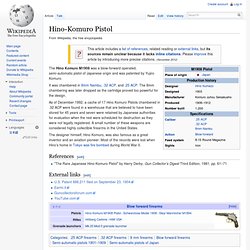
It was chambered in 8mm Nambu, .32 ACP, and .25 ACP. The 8mm chambering was later dropped as the cartridge proved too powerful for the design. As of December 1992, a cache of 17 Hino Komuro Pistols chambered in .32 ACP were found in a warehouse that are believed to have been stored for 45 years and seven were retained by Japanese authorities for evaluation when the rest were scheduled for destruction as they were not legally registered. A small number of these weapons are considered highly collectible firearms in the United States.
The designer himself, Hino Komuro, was also famous as a great inventor and an aviation pioneer. References[edit] Warrenpoint Ambush. The Warrenpoint ambush[6][7][8] or Narrow Water ambush[9][10][11] (also called the Warrenpoint massacre[12][13][14][15] or Narrow Water massacre)[16][17][18] was a guerrilla attack[19] by the Provisional Irish Republican Army (IRA)'s South Armagh Brigade on 27 August 1979.
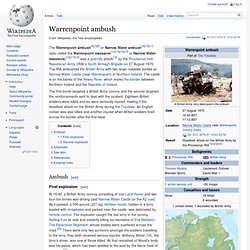
The IRA ambushed the British Army with two large roadside bombs at Narrow Water Castle (near Warrenpoint) in Northern Ireland. The castle is on the banks of the Newry River, which marks the border between Northern Ireland and the Republic of Ireland. The first bomb targeted a British Army convoy and the second targeted the reinforcements sent to deal with the incident. Eighteen British soldiers were killed and six were seriously injured, making it the deadliest attack on the British Army during the Troubles. An English civilian was also killed and another injured when British soldiers fired across the border after the first blast. Basra prison incident. The Basra prison incident was an event involving British troops in Basra, Iraq. On 19 September 2005, two undercover British Special Air Service soldiers disguised in Arab civilian garments and headdresses opened fire on Iraqi police officers after having been stopped at a roadblock. Two Iraqi officers were shot, at least one of whom died. [1] The two British men were arrested and taken to the Al Jameat police station.
British tanks encircled the jail where the men (whose photographs have been widely circulated but whose names have not been made public) were being held. A crowd gathered and began throwing stones and petrol bombs at the tanks, setting at least one ablaze. Kinetic bombardment. A kinetic bombardment is the act of attacking a planetary surface with an inert projectile, where the destructive force comes from the kinetic energy of the projectile impacting at very high velocities.

The concept is encountered in science fiction and is thought to have originated during the Cold War. Real life concepts and theories[edit] Project Thor[edit] Project Thor is an idea for a weapons system that launches kinetic projectiles from Earth's orbit to damage targets on the ground. Relativistic kill vehicle. A relativistic kill vehicle (RKV) or relativistic bomb is a hypothetical weapon system sometimes found in science fiction.
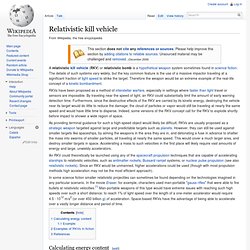
Mass driver. Artist's conception of a mass driver for lunar launch Although any device used to propel a ballistic payload is technically a mass driver, in this context a mass driver is essentially a coilgun that magnetically accelerates a package consisting of a magnetizable holder containing a payload. Once the payload has been accelerated, the two separate, and the holder is slowed and recycled for another payload. Mass drivers can be used to propel spacecraft in three different ways: A large, ground-based mass driver could be used to launch spacecraft away from Earth, the Moon, or another body. A small mass driver could be on board a spacecraft, flinging pieces of material into space to propel itself.
Another variation would have a massive facility on a moon or asteroid send projectiles to assist a distant craft. Miniaturized mass drivers can also be used as weapons in a similar manner as classic firearms or cannon using chemical combustion.
Prize rules. Prize rules state that passenger ships may not be sunk, crews of merchant ships must be placed in safety before their ships may be sunk (life boats are not considered a place of safety unless close to land); and only warships and merchant ships that are a threat to the attacker may be sunk without warning. Declaration of Paris, 1856[edit] The Rules[edit] Part IV, Art. 22 of the Treaty for the Limitation and Reduction of Naval Armaments, relates to submarine warfare. It states as follows:[2] In their action with regard to merchant ships, submarines must conform to the rules of international law to which surface vessels are subject.In particular, except in the case of persistent refusal to stop on being duly summoned, or of active resistance to visit or search, a warship, whether surface vessel or submarine, may not sink or render incapable of navigation a merchant vessel without having first placed passengers, crew and ship's papers in a place of safety. 20th century[edit]
Unrestricted submarine warfare. German U-boat Following the use of unrestricted submarine warfare by Germany in the First World War, countries tried to limit or even abolish submarines. Instead, the London Naval Treaty required submarines to abide by prize rules.
German school of fencing. Brotherhood of St. Mark.